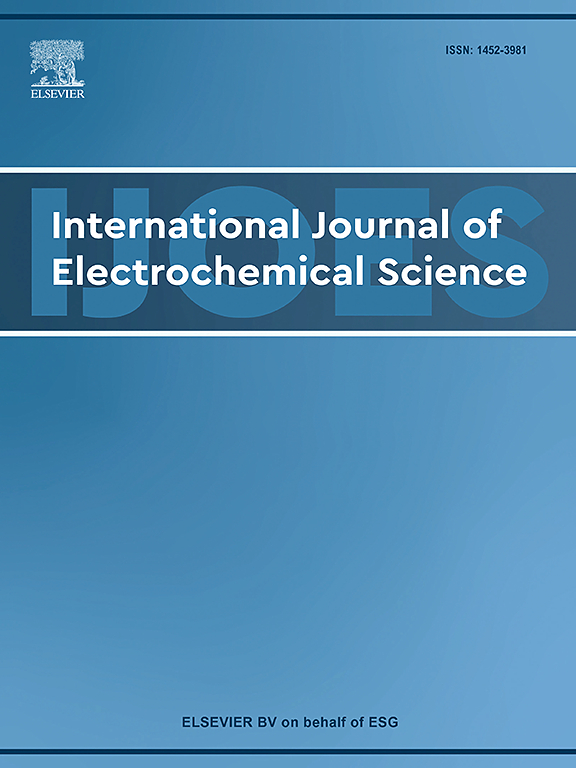恶二唑衍生物在模拟冷却水中作为铜(Cu58Zn40Pb2)缓蚀剂的电化学和理论研究
IF 1.3
4区 化学
Q4 ELECTROCHEMISTRY
International Journal of Electrochemical Science
Pub Date : 2025-04-30
DOI:10.1016/j.ijoes.2025.101034
引用次数: 0
摘要
采用动电位极化曲线(PDP)和电化学阻抗谱(EIS)研究了温度和浸泡时间对两种恶二唑衍生物2,5-二(3-甲基苯基)-1,3,4-恶二唑(3- mpox)和2,5-二(4-甲基苯基)-1,3,4-恶二唑(4-MPOX)在模拟冷却水系统(SCWS)溶液中对Cu58Zn40Pb2黄铜基体的防腐性能的影响。为了解释其作用方式,确定其防腐性能顺序,进行了DFT计算和MD模拟。PDP结果表明,3-MPOX和4-MPOX作为混合型缓蚀剂,在305 K时,3-MPOX和4-MPOX的防腐效率略有下降,分别为91 %和90 %,335 K时,3-MPOX和4-MPOX的防腐效率分别为81 %和78 %。吸附过程的热力学和动力学参数表明,这些化合物是通过物理吸附进行吸附的。此外,EIS结果表明,随着浸泡时间的增加,这些化合物的性能显著提高,10−3 m3 - mpox和10−3 m3 - mpox在浸泡24 h后分别达到98 %和95 %的极限。因此,对于两种作用温度和浸泡次数,发现缓蚀效率取决于-CH3在环中的位置,并遵循3-MPOX≥ 4-MPOX。最后,DFT计算表明,3-MPOX比4-MPOX的反应性更强,证实了实验所得的性能。MD模拟表明,3-MPOX和4-MPOX分子平行于Cu/Zn原子表面,随后被芳香苯的大部分C-O / C-N基团和CC键吸附。这些发现解释并证实了动作模式和获得的性能顺序。本文章由计算机程序翻译,如有差异,请以英文原文为准。
Electrochemical and theoretical investigation of oxadiazole derivatives as corrosion inhibitors for brass (Cu58Zn40Pb2) in simulated cooling water
The effect of temperature and immersion time on the anticorrosion character of two oxadiazoles derivatives, namely 2,5-bis(3-methylphenyl)-1,3,4-oxadiazole (3-MPOX) and 2,5-bis(4-methylphenyl)-1,3,4-oxadiazole (4-MPOX) for a brass Cu58Zn40Pb2 substrate in a simulated cooling water system (SCWS) solution was investigated using a potentiodynamic polarization curve (PDP) and electrochemical impedance spectroscopy (EIS). In order to explain the action mode and confirm the anticorrosion performance order, DFT calculations and MD simulation were conducted. The PDP results showed that 3-MPOX and 4-MPOX act as a mixed type inhibitor and their anticorrosion efficiency losses slightly with temperature electrolyte from 91 % and 90 % at 305 K to 81 % and 78 % at 335 K for 3-MPOX and 4-MPOX, respectively. Thermodynamic and kinetic parameters for the adsorption process indicated that these compounds adsorbed via physical adsorption. Additionally, the EIS results demonstrated that the performance of these compounds enhances remarkably with immersion time, reaching its extreme of 98 % and 95 % after 24 hours of immersion for 10−3 M 3-MPOX and 10−3 M 4-MPOX, respectively. Therefore, for two effect temperature and immersion times, it is found that the inhibition efficiency depends on the –CH3 position in the ring and follows the classmen: 3-MPOX ≥ 4-MPOX. Finally, the DFT calculations indicated that 3-MPOX is more reactive than 4-MPOX confirming the obtained experimental performance. MD simulation indicated that the 3-MPOX and 4-MPOX molecules are oriented parallel to the Cu/Zn atoms surface, succeeding adsorption by a great portion of the C-O / C-N groups and C![]() C bonds of aromatic benzene. These findings explained and confirmed the action mode and the obtained performance order.
C bonds of aromatic benzene. These findings explained and confirmed the action mode and the obtained performance order.
求助全文
通过发布文献求助,成功后即可免费获取论文全文。
去求助
来源期刊
CiteScore
3.00
自引率
20.00%
发文量
714
审稿时长
2.6 months
期刊介绍:
International Journal of Electrochemical Science is a peer-reviewed, open access journal that publishes original research articles, short communications as well as review articles in all areas of electrochemistry: Scope - Theoretical and Computational Electrochemistry - Processes on Electrodes - Electroanalytical Chemistry and Sensor Science - Corrosion - Electrochemical Energy Conversion and Storage - Electrochemical Engineering - Coatings - Electrochemical Synthesis - Bioelectrochemistry - Molecular Electrochemistry

 求助内容:
求助内容: 应助结果提醒方式:
应助结果提醒方式:


